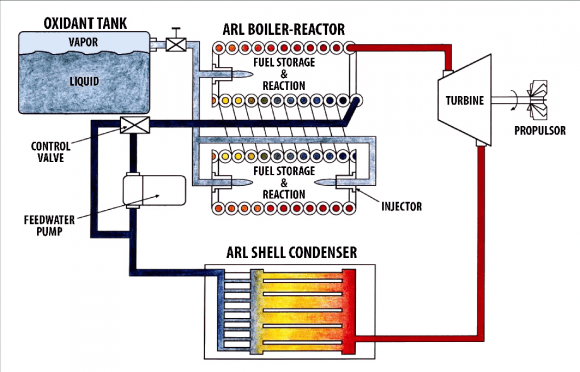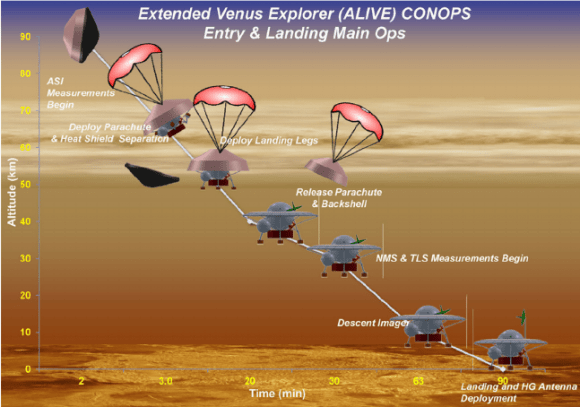In 2005, the Future In-Space Operations Working Group (FISOWG) was established with the help of NASA to assess how advances in spaceflight technologies could be used to facilitate missions back to the Moon and beyond. In 2006, the FISO Working Group also established the FISO Telecon Series to conduct outreach to the public and educate them on issues pertaining to spaceflight technology, engineering, and science.
Every week, the Telecon Series holds a seminar where experts are able to share the latest news and developments from their respective fields. On Wednesday, April 19th, in a seminar titled "An Air-Breathing Metal-Combustion Power Plant for Venus in situ Exploration", NASA engineer Michael Paul presented a novel idea where existing technology could be used to make longer-duration missions to Venus.
To recap the history of Venus exploration, very few probes have ever been able to explore its atmosphere or surface for long. Not surprising, considering that the atmospheric pressure on Venus is 92 times what it is here on Earth at sea level. Not to mention the fact that Venus is also the hottest planet in the Solar System - with average surface temperatures of 737 K (462 °C; 863.6 °F).

Although similar in size and composition to the Earth, Venus has an extremely dense atmosphere with clouds that produce sulfuric acid rain. Credit: NASA
Hence why those few probes that actually explored the atmosphere and surface in detail - like the Soviet-era Venera probes and landers and NASA's Pioneer Venus multiprobe - were only able to return data for a matter of hours. All other missions to Venus have either taken the form of orbiters or consisted of spacecraft conducting flybys while en route to other destinations.
Having worked in the fields of space exploration and aerospace engineering for 20 years, Michael Paul is well-versed in the challenges of mounting missions to other planets. During his time with the John Hopkins University Applied Physics Laboratory (JHUAPL), he contributed to NASA's Contour and Stereo missions, and was also instrumental in the launch and early operations of the MESSENGER mission to Mercury.
However, it was a flagship-level study in 2008 - performed collaboratively between JHUAPL and NASA's Jet Propulsion laboratory (JPL) - that opened his eyes to the need for missions that took advantage of the process known as In-Situ Resource Utilization (ISRU). As he stated during the seminar:
"That year we actually studied a very large mission to Europa which evolved into the current Europa Clipper mission. And we also studied a flagship mission to the Saturn, to Titan specifically. The Titan-Saturn system mission study was a real eye-opener for me in terms what could be done and why we should be doing a lot of more adventurous and more aggressive exploration of in-situ in certain places."
The flagship mission to Titan was the subject of Paul's work since joining Penn Sate's Applied Research Laboratory in 2009. During his time there, he became a NASA Innovative Advanced Concepts Program (NIAC) Fellow for his co-creation of the Titan Submarine. For this mission, which will explore the methane lakes of Titan, Paul helped to develop underwater power systems that would provide energy for planetary landers that can't see the Sun.
Having returned to JHUAPL, where he is now the Space Mission Formulation Lead, Paul continues to work on in-situ concepts that could enable missions to locations in the Solar System that present a challenge. In-situ exploration, where local resources are relied upon for various purposes, presents numerous advantages over more traditional concepts, not the least of which is cost-effectiveness.
Consider mission that rely on Multi-Mission Radioisotope Thermoelectric Generators (MMRTG) - where radioactive elements like Plutonium-238 are used to generate electricity. Whereas this type of power system - which was used by the Viking 1 and 2 landers (sent to Mars in 1979) and the more recent Curiosity rover - provides unparalleled energy density, the cost of such missions is prohibitive.
What's more, in-situ missions could also function in places where conventional solar cells would not work. These include not only locations in the outer Solar System (i.e. Europa, Titan and Enceladus) but also places closer to home. The South Pole-Aitken Basin, for example, is a permanently shadowed location on the Moon that NASA and other space agencies are interesting in exploring (and maybe colonizing) due to the abundance of water ice there.
But there's also the surface Venus, where sunlight is in short supply because of the planet's dense atmosphere. As Paul explained in the course of the seminar:
"What can you do with other power systems in places where the Sun just doesn't shine? Okay, so you want to get to the surface of Venus and last more than a couple of hours. And I think that in the last 10 or 15 years, all the missions that [were proposed] to the surface of Venus pretty much had a two-hour timeline. And those were all proposed, none of those missions were actually flown. And that's in line with the 2 hours that the Russian landers survived when they got there, to the surface of Venus."

Diagram of a Sterling Engine, part of proposed mission to Europe ("Fire on Europa"). Credit: lpi.usra.edu
The solution to this problem, as Paul sees it, is to employ a Stored-Chemical Energy and Power System (SCEPS), also known as a Sterling engine. This proven technology relies on stored chemical energy to generate electricity, and is typically used in underwater systems. But repurposed for Venus, it could provide a lander mission with a considerable amount of time (compared to previous Venus missions) with which to conduct surface studies.
For the power system Paul and his colleagues are envisioning, the Sterling engine would take solid-metal lithium (or possibly solid iodine), and then liquefy it with a pyrotechnic charge. This resulting liquid would then be fed into another chamber where it would combined with an oxidant. This would produce heat and combustion, which would then be used to boil water, spin turbines, and generate electricity.
Such a system is typically closed and produces no exhaust, which makes it very useful for underwater systems that cannot compromise their buoyancy. On Venus, such a system would allow for electrical production without short-lived batteries, an expensive nuclear fuel cell, and could function in a low solar-energy environment.
An added benefit for such a craft operating on Venus is that the oxidizer would be provided locally, thus removing the need for an heavy component. By simply letting in outside CO2 - which Venus' atmosphere has in abundance - and combining with the system's liquified lithium (or iodine), the SCEPS system could provide sustained energy for a period of days.

The Advanced Lithium Ion Venus Explorer (ALIVE), derived from the COMPASS final report (2016). Credit: Oleson, Steven R., and Michael Paul.
With the help of NASA's Innovative Advanced Concepts (NIAC) and funding from the Hot Operating Temperature Technology (HOTTech) program - which is overseen by NASA's Planetary Science Division - Paul and his colleagues were able to test their concept, and found that it was capable of producing sustained heat that was both controllable and tunable.
Further help came from the Glenn Research Center's COMPASS lab, were engineers from multiple disciplines performs integrated vehicle systems analyses. From all of this, a mission concept known as the Advanced Lithium Venus Explorer (ALIVE) was developed. With the help of Steven Oleson - the head of GRC's COMPASS lab - Paul and his team envision a mission where a lander would reach the surface of Venus and study it for 5 to 10 days.
All told, that's an operational window of between 120 and 240 hours - in other words, 60 to 120 times as long as previous missions. However, how much such a mission would cost remains to be seen. According to Paul, that question became the basis of an ongoing debate between himself and Oleson, who disagreed as to whether it would be part of the Discovery Program or the New Frontiers Program.
As Paul explained, missions belonging to the former were recently capped at the $450 to $500 million level while the latter are capped at $850 million. "I believe that if you did this right, you could get it into a Discovery mission," he said. "Here at APL, I've seen really complicated ideas fit inside a Discovery cost cap. And I believe that the way we crafted this mission, you could do this for a Discovery mission. And it would be really exciting to get that done."

Artist's impression of the surface of Venus. Credit: ESA/AOES
From a purely technological standpoint, this not a new idea. But in terms of space exploration, it has never been done before. Granted, there are still many tests which would need to be conducted before any a mission to Venus can be planned. In particular, there are the byproducts created by combusting lithium and CO2 under Venus-like conditions, which already produced some unexpected results during tests.
In addition, there is the problem of nitrogen gas (N2) - also present in Venus' atmosphere - building up in the system, which would need to be vented in order to prevent a blowout. But the advantages of such a system are evident, and Paul and his colleagues are eager to take additional steps to develop it. This summer, they will be doing another test of a lithium SCEPS under the watchful eye of NAIC.
By this time next year, they hope to have completed their analysis and their design for the system, and begin building one which they hope to test in a controlled temperature environment. This will be the first step in what Paul hopes will be a three-year period of testing and development.
"The first year we're basically going to do a lot of number crunching to make sure we got it right," he said. "The second year we're going to built it, and test it at higher temperatures than room temperature - but not the high temperatures of Venus! And in the third year, we're going to do the high temperature test."
Ultimately, the concept could be made to function in any number of high and low temperature conditions, allowing for cost-effective long-duration missions in all kinds of extreme environments. These would include Titan, Europa and Enceladus, but also Venus, the Moon, and perhaps the permanently-shadowed regions on Mercury's poles as well.
Space exploration is always a challenge. Whenever ideas come along that make it possible to peak into more environments, and on a budget to boot, it is time to start researching and developing them!
To learn more about the results of the SCEPS tests, and for more information on the proposed systems, check out the slideshow and audio recording of this week's FISO seminar. You can also check out the presentation titled "A Combustion-Driven Power Plant For Venus Surface Exploration", which Paul and Oleson made during the 48th Lunar and Planetary Conference (which ran from March 20th-24th, 2017).
Further Reading: FISO